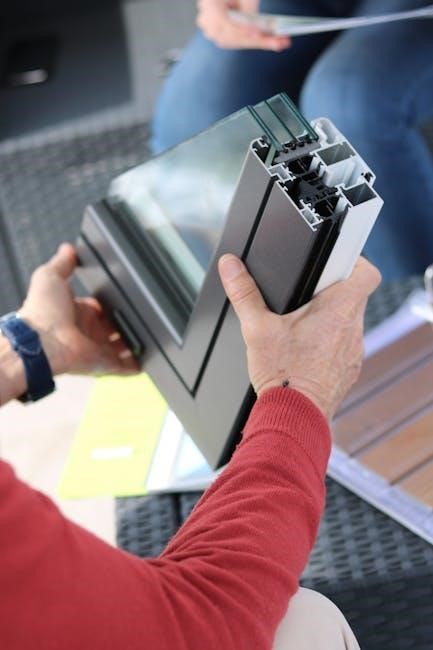The XNX Universal Transmitter is a versatile gas detection solution designed for hazardous areas, offering compatibility with multiple sensor types and flexible installation options.
1.1 Overview of the XNX Universal Transmitter

The XNX Universal Transmitter is a cutting-edge gas detection device designed for hazardous environments. It supports various sensor types, including electrochemical, infrared, and catalytic bead, ensuring versatility in gas monitoring. With standard 4-20mA wiring and optional communication protocols like HART, Modbus, and Fieldbus, it offers seamless integration into industrial systems. Its rugged design and global certifications make it suitable for worldwide deployment. The transmitter’s modular architecture allows for easy customization, catering to diverse industrial needs while maintaining high performance and reliability in extreme conditions. This flexibility ensures efficient gas detection and safety across various applications.
1.2 Key Features and Benefits
The XNX Universal Transmitter offers a wide range of sensors on a single platform, reducing installation and maintenance costs. Its modular design allows users to customize inputs and outputs, saving time and money. With five threaded ports available in metric or NPT versions, it provides exceptional installation flexibility. The transmitter supports standard 4-20mA wiring and advanced communication protocols like HART and Modbus, enabling easy integration into existing systems. Its ruggedized mounting options ensure durability in harsh environments. Additionally, the transmitter supports various gas detection technologies, including electrochemical, infrared, and catalytic bead sensors, making it a comprehensive solution for industrial gas monitoring needs.
System Requirements and Compatibility
The XNX Universal Transmitter is compatible with various gas detection systems and supports multiple sensor types, ensuring seamless integration and reliable performance in hazardous environments.
2.1 Supported Sensor Types
The XNX Universal Transmitter supports a wide range of sensor types, including electrochemical, infrared, and catalytic bead sensors. It is compatible with popular models like the Sensepoint Optima Plus, Searchline Excel, and Model 705 HT. This versatility ensures that users can select the most suitable sensor for their specific gas detection needs. The transmitter’s design allows for easy integration with these sensors, providing accurate and reliable gas monitoring. Additionally, it supports standard 4-20mA wiring and advanced communication protocols like HART, Modbus, and Fieldbus, enhancing its compatibility with various gas detection systems.
2.2 Compatibility with Gas Detection Systems
The Honeywell XNX Universal Transmitter is designed to seamlessly integrate with a wide range of gas detection systems, ensuring reliable performance in various industrial environments. It supports standard communication protocols such as HART, Modbus, and Fieldbus, enabling easy connectivity with existing infrastructure. The transmitter is compatible with multiple gas types, including toxic and combustible gases, and works alongside sensors like Sensepoint Optima Plus and Searchline Excel. Its modular design allows for straightforward integration with other safety systems, making it a versatile solution for comprehensive gas monitoring. This compatibility ensures enhanced safety and efficiency across industries.

Safety Precautions and Warnings
Read and understand this manual before installing, operating, or maintaining the transmitter. Pay attention to warnings and cautions. Designed for hazardous areas, follow safety guidelines for proper safe operation.
3.1 General Safety Guidelines
Always read and understand this manual before installing, operating, or maintaining the XNX Universal Transmitter. Adhere to all safety instructions and warnings provided. Ensure proper installation in hazardous areas, following all applicable regulations. Conduct regular testing and calibration to maintain functionality. Avoid unauthorized modifications or repairs. Use only approved sensors and accessories. Follow proper grounding and wiring procedures to prevent electrical hazards. Ensure the device is correctly configured for the specific gas type and range. Refer to technical support if unsure about any procedure. Safety guidelines are crucial to ensure reliable performance and protection in hazardous environments.

3.2 Hazardous Area Certifications
The XNX Universal Transmitter is certified for use in hazardous areas, meeting global standards such as ATEX, IECEx, and CSA. These certifications ensure the device operates safely in explosive environments. Proper installation and maintenance are critical to maintaining certification compliance. Always verify that the transmitter and connected sensors meet local and international safety regulations. The certifications cover various hazardous area classifications, ensuring reliable performance in diverse industrial settings. Compliance with these standards guarantees the transmitter’s ability to function safely and effectively in potentially dangerous environments, protecting personnel and equipment from gas-related hazards. Adherence to certification requirements is non-negotiable for safe operation.

Installation Process

The XNX Universal Transmitter offers flexible installation options, including integral mounting tabs and multiple port configurations, ensuring ease of setup in various industrial environments.
4.1 Mounting the Transmitter
The XNX Universal Transmitter provides multiple mounting options for flexible installation. It features integral mounting tabs, allowing easy attachment to surfaces or supports. Additionally, the transmitter offers five threaded ports in metric or NPT versions, enabling secure and durable connections. Ruggedized mounting options further enhance its suitability for harsh industrial environments. These features ensure the transmitter can be installed in various configurations, accommodating specific site requirements while maintaining reliability and performance. Proper mounting ensures optimal functionality and safety in hazardous areas, adhering to international standards for gas detection systems.
4.2 Wiring and Connectivity Options
The XNX Universal Transmitter offers flexible wiring and connectivity options to ensure seamless integration with various gas detection systems. It supports standard 4-20mA wiring and is compatible with advanced communication protocols such as HART, Modbus, and Fieldbus. This versatility allows for easy connection to control systems and enables remote monitoring and configuration. The transmitter also supports multiple sensor types, including electrochemical, infrared, and catalytic bead sensors, ensuring compatibility with a wide range of gas detection applications. Proper wiring ensures reliable performance, and the transmitter’s design simplifies installation and maintenance in hazardous environments.

Configuration and Setup
The XNX Universal Transmitter simplifies setup with user-friendly configuration options, enabling precise gas type, range, and alarm level settings to ensure accurate gas detection and reliable performance.
5.1 Setting Up Gas Type and Range
Setting up the gas type and range on the XNX Universal Transmitter involves selecting the appropriate gas sensor and configuring the detection parameters. Users can choose from a variety of sensor types, including electrochemical, infrared, and catalytic bead. The transmitter allows for precise range setting to match the specific gas detection requirements. After installing the sensor, the gas type and range must be confirmed to ensure accurate measurements. This step is critical for proper functionality and safety. The transmitter’s intuitive interface simplifies the process, guiding users through each configuration step. Always refer to the sensor’s manual for specific setup instructions.
5.2 Alarm Levels and Calibration Procedures
Configuring alarm levels on the XNX Universal Transmitter ensures timely alerts for gas detection thresholds. Users can define low and high alarm points to suit specific safety requirements. Calibration is critical for accuracy and involves zero and span adjustments. The transmitter supports HART and Modbus communication for remote calibration. Always follow the manual’s procedures to ensure proper setup. Regular recalibration is recommended to maintain performance. Incorrect settings can lead to false alarms or failures. Refer to the sensor-specific instructions for detailed calibration steps. Properly configured alarm levels and calibration ensure reliable gas detection and compliance with safety standards.

Maintenance and Troubleshooting
Regular maintenance ensures optimal performance. Check sensors, connections, and wiring. Troubleshooting involves identifying issues like sensor faults or communication errors and resolving them using diagnostic tools.
6.1 Routine Maintenance Tasks
Regular maintenance is essential to ensure the XNX Universal Transmitter operates efficiently. Inspect sensors for contamination or damage, and clean or replace them as needed. Verify wiring connections are secure and free from corrosion. Perform calibration checks according to the manufacturer’s guidelines to maintain accuracy. Additionally, check the transmitter’s firmware for updates and install the latest version if available. Clean the transmitter’s exterior to prevent dust buildup. Document all maintenance activities for future reference. Always follow the procedures outlined in the technical manual to ensure safety and compliance with regulatory standards.
6.2 Common Issues and Solutions
Common issues with the XNX Universal Transmitter include sensor contamination, wiring faults, and calibration drift. For sensor issues, clean or replace the sensor as needed. Check wiring connections for tightness and integrity, and rewire if damaged. If calibration drift occurs, perform a zero and span calibration following the manual. Communication errors with connected systems can be resolved by verifying Modbus or HART settings. Ensure firmware is up-to-date, as outdated versions may cause compatibility problems. Always refer to the troubleshooting guide in the manual for detailed solutions. If issues persist, contact Honeywell support for assistance.
Compliance and Certifications
The XNX Universal Transmitter meets global standards for hazardous area equipment, ensuring regulatory compliance and safety. It holds international certifications, making it a reliable choice worldwide.
7.1 Regulatory Compliance
The XNX Universal Transmitter is designed to meet stringent global regulations for hazardous area equipment. It adheres to international standards such as ATEX, IECEx, and FM, ensuring compliance with safety and performance requirements. The transmitter is certified for use in explosive atmospheres, guaranteeing reliability in harsh environments. Compliance with these regulations ensures that the device operates safely and effectively across various industries. By meeting these standards, the XNX Universal Transmitter provides users with a trusted solution for gas detection in hazardous locations worldwide.
7.2 International Standards and Approvals
The XNX Universal Transmitter is certified to global standards, including ATEX, IECEx, FM, CSA, and UL, ensuring safe operation in hazardous areas worldwide. These approvals confirm compliance with international regulations for explosion-proof devices. The transmitter meets rigorous testing criteria for environmental durability, electromagnetic compatibility, and performance reliability. Its certifications are recognized across regions, making it a trusted solution for industrial gas detection. Compliance with these standards ensures the device operates safely and efficiently in diverse global applications, adhering to local and international safety requirements.
Additional Resources
Access technical documentation, manuals, and troubleshooting guides for the XNX Universal Transmitter online. Manufacturer support and contact information are also available for assistance and inquiries.

8.1 Technical Documentation and Manuals
The XNX Universal Transmitter’s technical documentation and manuals provide comprehensive guidance on installation, operation, and maintenance. These resources include detailed procedures for mounting, wiring, and configuring the device. The manual also covers troubleshooting tips and calibration processes. Additionally, it outlines compatibility with various sensor types, such as electrochemical, infrared, and catalytic bead sensors. Users can access downloadable PDF versions of the manual, ensuring easy reference. The documentation is designed to support technicians and engineers in ensuring optimal performance and compliance with safety standards. Regular updates to the manual are available online for the latest technical information.
8.2 Manufacturer Support and Contact Information
Honeywell provides comprehensive support for the XNX Universal Transmitter, ensuring optimal performance and compliance. Users can access technical support via phone, email, or the official website. The manufacturer offers detailed resources, including downloadable manuals and FAQs. For specific inquiries, customers can contact Honeywell’s dedicated support team, available 24/7 in multiple regions. Additionally, regional offices and authorized distributors provide localized assistance. Honeywell’s commitment to customer satisfaction ensures reliable support for installation, troubleshooting, and maintenance, making the XNX Universal Transmitter a trusted choice for gas detection systems worldwide.